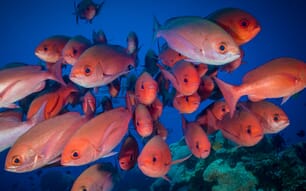Identity
Gadus morhua Linnaeus, 1758 [Gadidae]
FAO Names: En - Atlantic cod, Fr - Morue de l'Atlantique, Es - Bacalao del Atlántico
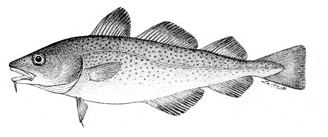
Biological Features
Head relatively narrow, interorbital space 15 to 22% of head length. Predorsal distance less than about 33% of length; Colour: variable, brownish to greenish or grey dorsally and on upper side, pale ventrally.
Peritoneum silvery.
View SIDP Species fact sheet
Images Gallery
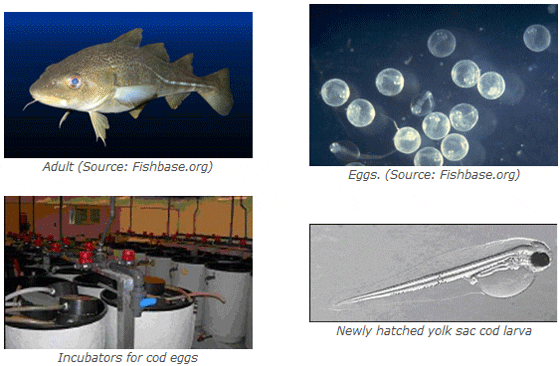
Profile
Historical Background
Atlantic cod is one of the most important commercial fish species in Northern Europe and North America’s eastern coast. Large traditional fisheries dates back many centuries and have been an important basis for many coastal communities, and important merchandise. Atlantic cod is divided in several more or less separate stocks with different population size and harvest regime. The largest fishery is on the Northeast Arctic and Icelandic cod stocks. Cods stocks in North America were heavily reduced during the 1980s and today the fishery is very low compared to historical levels. A similar situation exists for several of the European stocks. The total worldwide catch in 2008 was ~765 000 tonnes, of which about 73 per cent is taken by Norway, Iceland and Russian Federation. Cod is highly appreciated as food and is sold as fresh fillets, salted or as stockfish. Cod from aquaculture are popular in the market and often obtains higher prices than wild caught cod.
The farming of Atlantic cod has also a long history. In the 1880s the Norwegian sea-captain G.M. Dannevig started experiments with the artificial rearing of cod. His aim was to increase coastal cod stocks by hatching and releasing yolk sac larvae of cod. Similar experiments were performed in the United States of America and Canada, and during the period 1884-1971 billions of cod larvae were released in these countries. Dannevig also produced some thousand juvenile cod, which were fed on natural zooplankton in seawater enclosures (natural rock basins, with or without connections to the sea but where seawater supply is controlled and predators removed). These experiments were the basis for the development of modern cod aquaculture. Around 1980 the use of sea-water enclosures for juvenile cod production was begun again by Norwegian scientists, and in 1983 one was able for the first time to produce a significant amount (75 000) of cod juveniles. As with most other marine species, juvenile production has been the major biological bottleneck.
The ‘breakthrough’ of juvenile production triggered some commercial aquaculture of cod during the 1980s but profitability was low and all enterprises closed down after few years. These first commercial aquaculture trials were based on juveniles produced from extensive systems. Such systems give high quality juveniles but production capacities are limited. Around 2000 a new ‘wave’ of cod aquaculture developed, also this time mainly in Norway but also in United States of America, Canada, United Kingdom, Iceland and other countries. At this time juvenile production technology was further developed and large hatcheries, based on intensive production protocols similar to those used for seabass/seabream, were used.
Together with new advances in light manipulation of broodstock to achieve year-round egg production, as well as reducing the problem of early sexual maturation, the biological basis for cod aquaculture was achieved. Investments in cod aquaculture enterprises, both hatcheries and ongrowing farms began to accelerate. Within a few years an annual production capacity in the order of 60 million juveniles and around 400 ongrowing sites was built up in Norway alone. This corresponds to a theoretical annual production capacity of about 180 000 tonnes. However, the financial market crisis in 2008, together with much more challenging biological problems than were expected has caused most of these enterprises to close down. Today (2010) cod aquaculture is under consolidation.
Main Producer Countries
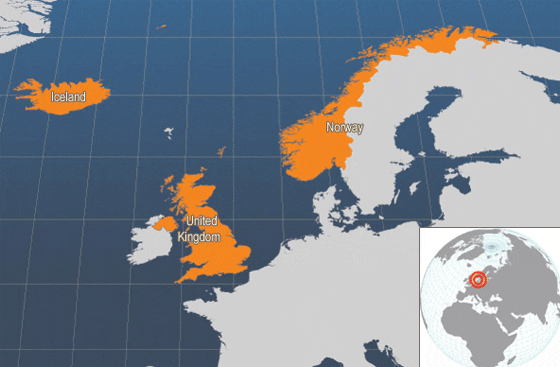
Main producer countries of Gadus morhua (FAO Fishery Statistics, 2006)
Habitat and Biology
Atlantic cod has a wide distribution on both sides of the Atlantic Ocean. At the western side it ranges from Cape Hatteras in the south to around Greenland in the north, and on the eastern cost from Biscaya in south to the Barents Sea in North. Within this area cod may tolerate summer temperatures over 20 °C and winter temperatures around zero. Even though cod in some areas, like the Gulf of Bothnia, may tolerate very low salinities (<10‰) most cod stocks experience much higher salinities (28-35‰).
Cod is a batch spawner, spawning 10-20 batches during a 2-3 month period in December – June (dependent on stock). Egg size is around 1.4 mm and fecundity accordingly high (500 000–1 000 000 eggs per kg female weight for farmed cod). The eggs are planktonic and hatch after approximately two weeks (5 °C, 70 day-degrees). The larvae prey on various zooplankton (rotifers, calanoid copepod nauplii, etc.) at first. After a few months the juveniles become more benthic and start schooling. Juvenile and adult cod prey on a variety of prey items, both benthic and pelagic; crustaceans and fish (including cannibalism) are usually the main diet. Some cod stocks perform large migrations between feeding in the ocean and spawning along the coast, while other stocks are very stationary during their whole life. Growth and age/size at maturity also vary widely between different cod stocks. Coastal cod in the southern regions may reach sexual maturity when they are 2-4 years old (40 cm) while some oceanic stocks, such as North East Arctic cod may be 6-9 years and 60 cm at their first spawning.
Production
Production Cycle
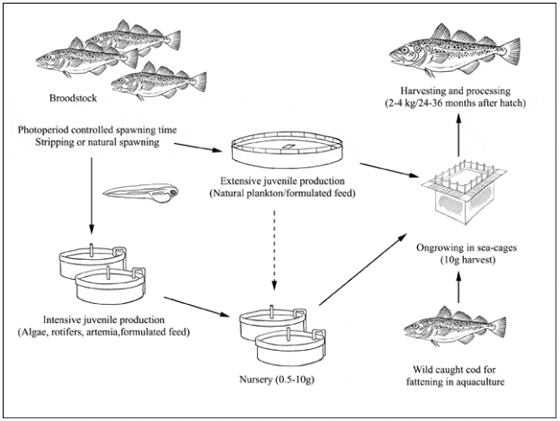
Production Cycle of Gadus Morhua
Production Systems
Seed Supply
Modern cod hatcheries have to either keep their own broodstock or get egg supplies from specialized breeding facilities. Both in Norway and Canada breeding programmes have started and genetic material with enhanced production parameters are now becoming available.
Hatchery Production
Cod spawn naturally in tanks during spring (February – April in Norway) but they can relatively easy be manipulated to spawn at other times of the year using photoperiod adjustment. A hatchery may have up to four-five different broodstock groups spawning at different times, ensuring a stable year-round use of the facility. In practice this will be regulated by the demand for juvenile cod; thus when demand is low fewer broodstock groups will be held. Cod spawns ideally every second-fourth day during the spawning season, giving a total of perhaps 15 batches, each averaging 500 ml (~250 000 eggs). However, large individual differences exist, and some of the captive females may have problems in releasing the ova. Fertilized eggs can either be obtained by collecting naturally spawned eggs from spawning tanks/cages with males and females, or ova and milt can be stripped for artificial fertilization.
The fertilized eggs are floated in the incubators and hatch within two-three weeks (70 day-degrees). Gentle aeration in the incubators is often used to prevent clogging on the outlet sieves. After hatching the larvae have a yolk-sac lasting for about one week but feeding has to start before the yolk is exhausted.
Basically, two production systems exist: intensive and extensive. The intensive system is now dominant, due to its higher and easier scalable production compared to extensive rearing. However, the intensive juvenile production system is quite new, having had serious problems with deformed juveniles. These problems have been reduced now (2010). Production methods for juvenile cod are quite new and large differences still exist between different production sites.
Intensive System
Newly hatched cod larvae are transferred to rearing tanks, usually 1-5 m diameter (~1-5 m3) at a density of 100-200 larvae/litre, where they are supplied with live feed. The rotifer Brachionus plicatilis is used during the first period, very often in combination with algae. The algae are produced in the hatchery or provided as a paste or concentrate bought from a dealer. The cod larvae are fed on enriched rotifers until weaning to formulated feed at an age of three-four weeks, or alternatively weaned somewhat later after an intermediate period during which Artemia are supplied. The rearing temperature should be rather low (6-8 °C) during the early larval period to reduce problems with malformations, but is gradually increased to about 12 °C for juvenile cod. Cod juveniles can be stocked in sea cages from a size of about 0.5 g (4 cm) but are very often kept in tanks until they reach a larger size, and thereafter transferred to ongrowing sites (usually cages).
Extensive System
The extensive method of rearing cod larvae to juveniles is based on much lower densities of both cod larvae and their prey, which are natural zooplankton. Extensive production may be carried out in a wide range of facilities, ranging from large seawater ponds (>200 000 m3/50 000 m2) to small plastic pens (~5 m3) floating in the sea that are operated more like intensive systems. Natural occurring zooplankton are the major feed during the first weeks. To increase natural zooplankton beyond natural levels, fertilization, filtration from the sea or cultured plankton may be supplied. Juveniles are harvested at a size of 0.1-1.0 g and thereafter transferred to ongrowing in cages or more usually to intermediate juvenile nursery facilities (tanks/cages) before they are put in ongrowing facilities.
Alternative Source of Juveniles
An alternative to hatchery produced juveniles is to collect young wild cod (over the legal size limit) by Danish seine or other means and to feed them in cages to market size. This capture-based aquaculture strategy has to some extent been used in Iceland and northern Norway.
Ongrowing Techniques
The ongrowing of cod is based on traditional cage farming, similar to salmon farming, using various types of sea-cages ranging from 5 x 5 m to 35 x 35 m in size, or circular net pens with circumferences up to 90 m and up to 50 m deep.
Under farming conditions some of the male cod mature sexually as one year old, while the remainder of the males and all females will normally mature at two years of age. This means that some mature before they have reached market size; thus early maturation is a major threat to cod farming from an economical point of view. The use of continuous light over the cages is therefore common; this reduces but not completely removes the problem with early maturation. Protocols for the production of sterile, all-female cod are therefore under development.
Feed Supply
During the on-rearing period cod are usually fed on extruded dry feeds, very similar to those used in the farming of salmonids. However, cod need a higher protein to fat ratio compared to salmon and do not utilize carbohydrates effectively. A typical ongrowing feed for cod has a protein/fat/carbohydrate ratio of approximately 50/15/10. The feed is mainly based on marine protein (fishmeal), although plant proteins and oil can replace some of the marine ingredients in order to make a less expensive feed. In Norway commercial feeds designed for cod were available.
Harvesting Techniques
The market size for cod is usually 2-4 kg and is achieved 24-36 months after hatching. Prices are generally highest for large fish but production costs, and particularly the onset of sexual maturation will often cause the farmer to deliver a fish of lower size than desired.
When the cod are ready for harvest, they are transferred via a well boat to a slaughterhouse for processing.
Handling and Processing
Traditionally, wild cod has many applications. Farmed cod are almost exclusively sold fresh as gutted or as fillets/loins. Pre-rigor filleting can give more value to farmed cod related to wild cod. Salted cod from aquaculture may also have a potential in the future.
Production Costs
In Norway, production costs have been estimated to be around USD 4.00-6.00/kg (2009), but the variation is large. Production costs are very close to the market price (and for many companies higher than the market price). However, the market price is also quite variable, depending on the situation in the wild cod fishery as well as other factors. Lower growth than expected from the results of earlier experiments and early sexual maturation increases the length of the production cycle and hence the production costs. Losses, as mortalities caused by diseases, predation and cannibalism, deformities and escapes from the cages, have also been more severe than expected and contribute to the relatively high production costs. These problems have resulted in several companies abandoning the farming of Atlantic cod. However, some farmers with high quality juveniles and good husbandry seem to be able to achieve profitability. Since cod farming is in its beginnings, it is also likely that production costs will decrease significantly within a few years.
Diseases and Control Measures
A variety of diseases and parasites are known on farmed (and wild) cod. Those currently causing most problems for the aquaculture industry are francisellosis, listonellosis (vibriosis), atypical furunculosis and VNN. Diseases typically break out under suboptimal conditions, such as during handling or in periods with high temperatures. Cod juveniles are routinely vaccinated against vibriosis, which reduces the problem with this disease significantly. The development of a vaccine against atypical furunculosis is on-going. There is currently no vaccine against francisellosis, a bacterial disease that has caused considerable problems for cod farming in some areas.
In some cases antibiotics and other pharmaceuticals have been used in treatment but their inclusion in this table does not imply an FAO recommendation.
| DISEASE | AGENT | TYPE | SYNDROME | MEASURES |
| Listonellosis | Listonella anguillarum (previously called Vibrio anguillarum) | Bacteria | Fin erosions; haemorrhages, particularly in the head region | Juvenile vaccination; oral antibiotic treatment |
| Francisellosis | Francisella noatunensis | Bacteria | Moderate to extensive granuloma formation in internal organs | None documented. Broodstock screening (kidney biopsies); avoidance of high water temperature |
| Atypical furunculosis | Aeromonas salmonicida | Bacteria | Moderate to extensive granuloma formation in internal organs | Vaccination; oral antibiotic treatment |
| Lomosis | Loma branchialis | Microsporidia | Gill cysts; respiratory problems | None described |
| Trichodinidosis | Trichodina spp. | Ciliates | Respiratory problems; mucus secretion; itching | Bath treatment (formaldehyde) |
| Gyrodactylosis | Gyrodactylus spp. | Haptorworms (monogeneans) | Respiratory problems; mucus secretion; itching | Bath treatment (formaldehyde) |
| Black-spot | Cryptocotyle lingua | Fluke larvae (Trigenetic parasite) | Itching; black spots in skin and fillets; juvenile mortality in extensive culture | Prophylactic measures (pen distance to shore placement; periwinkle removal or avoidance |
Suppliers of Pathology Expertise
A variety of companies offer diagnostic services and assistance. Further information may be found in the following web sites, for example:
- Fiskehelse.
- Institute For EXperimental Pathology, University of Iceland, KELDUR.
- University of Prince Edward Island - Atlantic Veterinary College - Fish Health Services
Statistics
Production Statistics
Global Aquaculture Production of Gadus Morhua
(FAO Fishery Statistic)
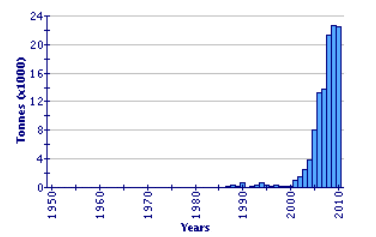
Estimates of farmed production in 2009 are 18 000 tonnes in Norway; 1 000 tonnes in the United States of America and Canada; and 2 000 tonnes in Iceland.
Market and Trade
Traditionally, wild cod has many applications. Farmed cod are almost exclusively sold fresh and gutted or as fillets/loins. Pre-rigor filleting can give more value to farmed cod related to wild cod. Salted cod from aquaculture may also have a potential in the future. Most of the Norwegian production is exported to the rest of Europe.
As opposed to many other aquaculture species, Atlantic cod aquaculture products are competing with cod from a large traditional fishery. Annual landings of cod are around 800 000 tonnes, 40 times the current production from aquaculture. However, the fishery is partly seasonal and has not the same possibility to deliver stable quantities and qualities throughout the year as aquaculture. Thus, farmed cod have some benefits that may compensate for the usually much higher production costs compared to wild caught cod. Most of the cod from aquaculture are therefore sold as fresh fish, either as fillets or loins or exported as whole fish and refined closer to the market. Norway, as the main producing country, exports about 80 per cent of its farmed cod. The main markets are Denmark, Sweden, France, Germany, Spain, the Netherlands and others.
Another issue for cod products is the competition from aquaculture ‘commodity species’. For example, Pangasius spp., farmed mainly in Viet Nam, has recently become popular in Europe due to its very low price, and may to some extent reduce the sale of more expensive species like cod.
Atlantic cod is well known and highly appreciated as food in most European countries and also in parts of North America and other countries like Brazil. The market size is thus not a limiting factor for cod aquaculture but currently high production costs make it difficult to compete with cod from traditional fisheries and with other cultured species.
Status and Trends
Cod aquaculture is a new industry that still has significant challenges in terms of understanding basic biological issues and developing production methods and protocols that ensure a stable and profitable production. A boom-like investment period during 2000-2008 and rapid biomass build-up was followed by an almost collapse after the financial crisis in 2008. It is likely that the growth in cod aquaculture production will be much slower than expected a few years ago, and the structure of the industry is currently quite unclear.
The major biological bottlenecks in cod farming are juvenile quality, early sexual maturation and diseases. Despite huge progress in intensive rearing protocols during recent years there are still some problems with bone deformities and low growth in farmed cod. These problems can be manifested at later stages, making it more difficult to sort out these individuals from the production at the hatchery. Thus low quality juveniles can significantly reduce the profitability for the farmers. It is likely that these problems will become less obvious as rearing protocols and larval feeds develop further.
Early sexual maturation is a common problem in aquaculture, including cod farming. The fish invest their energy in producing gonads to the expense of somatic growth. This reduces the profit for the farmer since the production cycle will be longer, feed conversation will decrease and mortality will increase. Additional light during on growing in cages reduces maturation, but does not stop it. Other methods, such as the production of all-female/triploid populations are under development; these may eliminate this problem within some years. However, it is not clear to what extent the market will accept such fish.
The development of efficient vaccines against the major disease threats is a prerequisite for the further development of cod aquaculture. Breeding programmes have started, both in Norway and in Canada, and within few years these will contribute to increased growth, better disease resistance and delayed maturation in farmed cod.
Main Issues
Aquaculture does interfere with the environment, wild populations or alternative uses of the coast. Several critical issues have been raised regarding cod aquaculture practice. The use of antibiotics in its production has been much higher in cod aquaculture compared to salmon aquaculture. Much of this is a result of a rapid growth of the industry and the appearance of new diseases. Further vaccine development will be necessary in order to reduce the use of antibiotics to an acceptable level. Cod easily find small holes in the net and are very good at escaping. This has been of great concern, particularly among fishermen. The spread of diseases and genetic material is not desirable and strict quality control of the nets and cage constructions are needed to minimize this problem. Mature cod will spawn in the cages, thus spreading fertilized eggs to the environment. This is another reason why reducing early sexual maturation would be valuable.
September 2012



